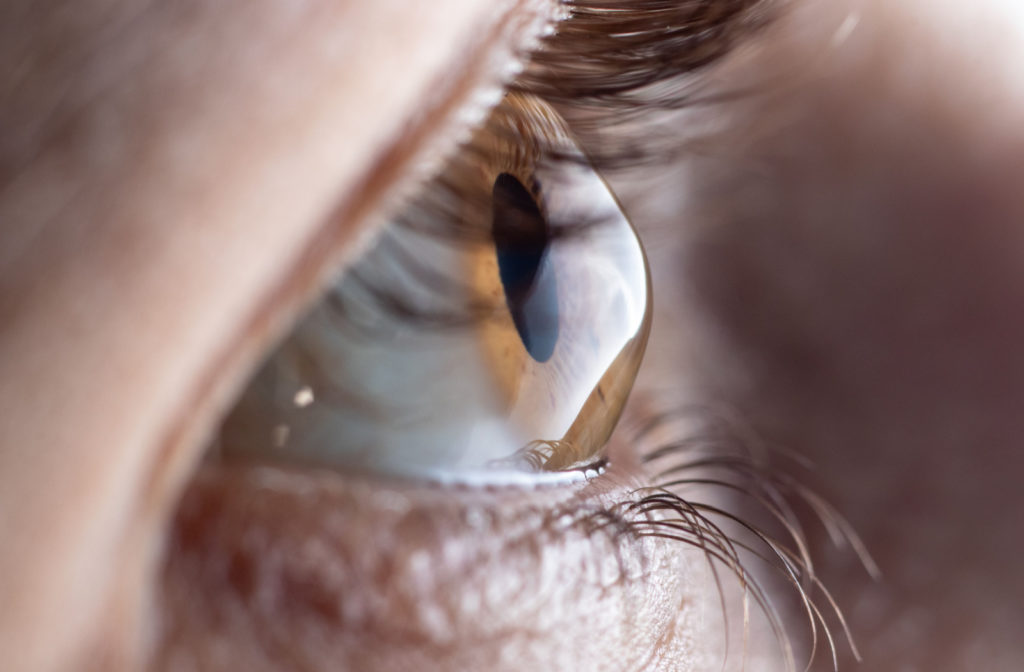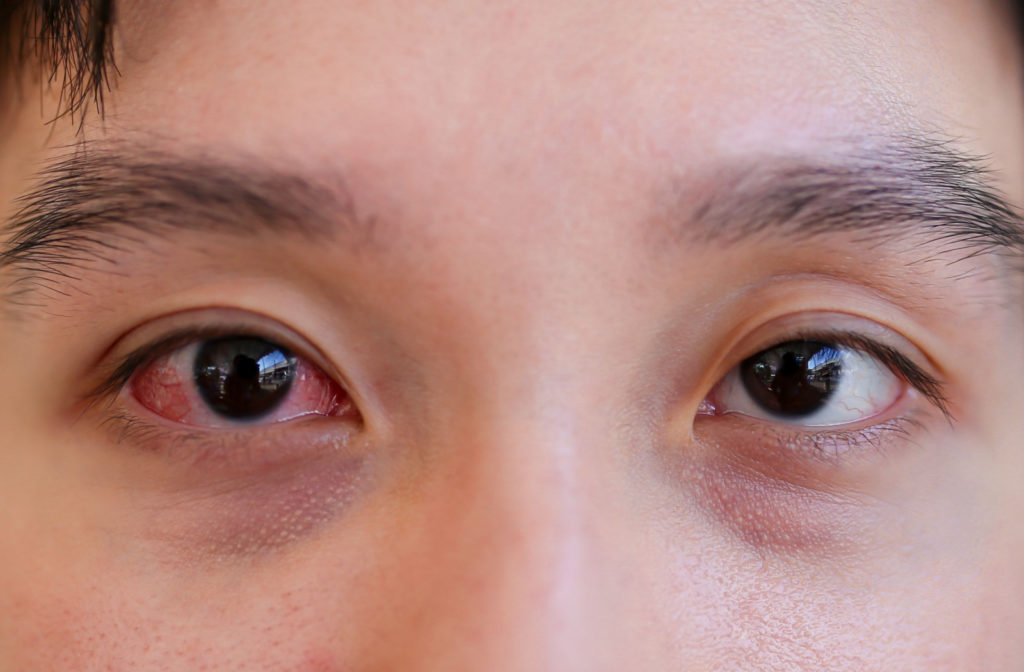Your eyes are your windows to the world, and keeping them healthy is crucial for maintaining your eyesight. However, plenty of eye diseases exist, all with their own unique symptoms and effects on your life. This makes it essential to learn to recognize the signs of an eye condition and how your optometrist can help treat them. Our team here at Total Vision Solana Beach has a list of ten of the most common eye diseases, their signs, and how they can be treated.
10 common eye diseases include:
- Dry eye
- Conjunctivitis
- Blepharitis
- Cataracts
- Uveitis
- Age-related macular degeneration
- Glaucoma
- Keratoconus
- Grave’s disease
- Diabetic retinopathy
Dry Eye
Dry eye develops when your eyes either can’t produce enough tears or aren’t able to produce tears of a high enough quality to do their job properly. It often feels like a dry, gritty, and burning sensation on the surface of your eye. This is an extremely common eye condition.
Dry Eye Signs & Symptoms
Dry eye typically manifests with the following symptoms:
- Dryness and discomfort in the eye
- Redness
- Light sensitivity
- Blurred vision that usually improves with blinking
How to Treat Dry Eye
Fortunately, dry eye can easily be treated with your optometrist’s help. They’ll likely recommend:
- Eye drops or artificial tears
- Warm compresses to stimulate the glands needed to produce healthy tears
- Nutritional or lifestyle changes to help give your eyes the nutrients they need
- Punctal plugs which stop your tears from draining too quickly
Conjunctivitis
Conjunctivitis, often called pink eye, is the inflammation or infection of the transparent membrane that lines your eyelid. There are three types of pink eye:
- Viral: This is extremely contagious. A viral infection in the eye causes it, and it usually goes away within a few days to two weeks.
- Bacterial: This is also highly contagious. A bacterial infection causes it and often causes a visible discharge along the edge of the eyes. This type of pink eye can be treated with antibiotics from your optometrist.
- Allergic pink eye: This is not contagious but often causes sneezing or an itchy throat alongside other standard allergic symptoms. This can be treated with over-the-counter allergy medication.
Blepharitis
Blepharitis is an inflammation of the eyelids that usually affects the area where the eyelashes grow. A bacterial infection often causes it but can also result from clogged oil glands along the edge of your eyelid.
Blepharitis Signs & Symptoms
Some common signs and symptoms of blepharitis include:
- Redness and swelling along the edge of your eyelids
- A gritty or burning sensation in your eyes
- Itchy eyelids
- Flaking of skin around the eyes
- Crusted eyelashes upon awakening
How to Treat Blepharitis
If you have blepharitis, you can find relief by:
- Using warm compresses
- Gently washing your eyelids with a mild cleanser recommended by your optometrist
- Applying antibiotic ointment or eye drops if there’s an underlying bacterial infection
Cataracts
Cataracts are a common eye condition when the eye’s natural lens becomes cloudy. Certain proteins in the lens can begin to break down and clump together, eventually obscuring light in the eye and creating a blurry area. Over time, this area can grow as more proteins clump together.
Cataract Signs & Symptoms
Cataract symptoms usually develop slowly and can include:
- Clouded, blurred, or dim vision
- Increasing difficulty with vision at night
- Sensitivity to light and glare
- Seeing halos around lights
- Frequent changes in eyeglass or contact lens prescription
- Fading or yellowing of colors
- Double vision in a single eye
If you notice any of these symptoms, seeing your optometrist for a comprehensive eye exam is important.
How to Treat Cataracts
Cataracts are generally treated through a simple surgery. The natural cloudy lens is removed and replaced with a clear artificial lens during this procedure. This procedure is one of the most commonly performed operations in the world.
Uveitis
Uveitis is a group of inflammatory diseases that cause swelling and damage to the eye tissues. Typically, this condition affects the middle layer of the eye, known as the uvea. If left untreated, it can lead to further complications and other eye diseases.
Uveitis Signs & Symptoms
The signs and symptoms of uveitis may vary depending on which part of the eye is affected. Some common symptoms include:
- Eye pain
- Redness
- Blurry vision
- Visible floaters
How to Treat Uveitis
When treating uveitis, your optometrist will take steps to help manage the inflammation. This is often done by prescribing corticosteroid eye drops, oral medications, or injections. In some cases, surgery may be necessary to prevent further complications.
Age-Related Macular Degeneration
Age-related macular degeneration, often called AMD for short, primarily affects the macula—the part of your retina responsible for clear and sharp central vision. The macula begins to degrade over time, leading to a loss of central vision.
AMD Signs & Symptoms
The early signs of age-related macular degeneration can be subtle but typically progress over time. Some of the symptoms associated with AMD include:
- A gradual loss of ability to see objects clearly
- Distorted vision where straight lines appear wavy
- A dark, blurry area or whiteout appearing in the center of your vision
- Difficulty in adapting to low light levels
- Increased blurriness of printed words
- Decreased intensity or brightness of colors
How to Treat AMD
Unfortunately, there is no cure for AMD. While some treatments can help slow the progression of AMD, they cannot restore vision that has already been lost. This makes it essential to recognize early signs and symptoms of AMD and seek help.
Glaucoma
Glaucoma is a group of eye diseases that can damage your eye’s optic nerve, which carries visual information between the eyes and the brain. Once the optic nerve is damaged, it’s permanent. This is why knowing the early signs and symptoms of glaucoma is so important.
Glaucoma Signs & Symptoms
There are several types of glaucoma, each with their own unique symptoms:
- Open-angle glaucoma: This is the most common type. It often develops slowly without noticeable symptoms until vision loss begins to develop.
- Angle-closure glaucoma: This develops suddenly and often causes pain, nausea, blurry vision, and extreme light sensitivity. If you notice these symptoms, seek immediate medical attention.
- Secondary glaucoma: This develops as a result of other eye conditions. Symptoms may vary depending on the original cause.
How to Treat Glaucoma
While there’s no cure for glaucoma, early diagnosis and treatment can significantly slow its progression. The main goal of treatment is to reduce the intraocular pressure and preserve the optic nerve. This can be done through:
- Prescription eye drops
- Oral medications
- Laser surgery
- Traditional manual surgery
Because the damage caused by glaucoma is permanent, it’s essential to visit the optometrist to get checked for these conditions regularly.

Keratoconus
Keratoconus is a progressive thinning of the cornea, eventually leading to the cornea beginning to bulge out. This typically develops due to the cornea losing its collagen fibers, causing it to become cone-shaped.
Keratoconus Signs & Symptoms
Keratoconus can affect each eye differently. Common signs and symptoms include:
- Gradual blurring of vision
- Distorted vision
- Increased nearsightedness or astigmatism
- Frequent changes in eyeglass prescription
- Light sensitivity
How to Treat Keratoconus
When treating keratoconus, your optometrist will likely recommend specialty contact lenses, such as scleral or hybrid lenses. These specialized lenses can help correct your vision and support the cornea. In more severe cases, a corneal transplant may be necessary.
Grave’s Disease
Grave’s disease is an autoimmune disorder that affects the thyroid gland, often leading to hyperthyroidism—a condition where your thyroid gland produces too much of the hormone thyroxine. One of the recognizable symptoms of Grave’s disease is a bulging or protruding eye.
Grave’s Disease Signs & Symptoms
Some common signs and symptoms of Grave’s disease include:
- Bulging eyes
- Red or swollen eyes
- Grittiness or irritation in the eyes
- Difficulty closing your eyes completely
How to Treat Grave’s Disease
When it comes to Grave’s disease, treatment is usually focused on regulating thyroid function to reduce symptoms. This is often done with eye drops, ointments, or medication. Surgery may be necessary in extreme cases, though this isn’t common.
Diabetic Retinopathy
Diabetes affects all parts of your body, including the eyes. Diabetic retinopathy is a condition where high blood sugar levels damage the small blood vessels in the retina, potentially leading to vision loss. In extreme cases, new blood vessels can grow, leaking fluid and blood.
Diabetic Retinopathy Signs & Symptoms
Diabetic retinopathy often has no early warning signs or symptoms. However, as it progresses, you may notice:
- Blurred vision
- Dark or empty areas in your vision
- Difficulty seeing at night
- Spots or floaters in your line of sight
How to Treat Diabetic Retinopathy
Treatment for diabetic retinopathy aims to manage diabetes itself. It helps to monitor your blood sugar levels and regularly visit an optometrist for diabetic eye exams to determine whether or not you’re developing this condition.
Eye Care in Solana Beach
When it comes to conditions like the ten listed above, prevention is often easier than treatment. One of the easiest ways to prevent eye diseases is through regular eye exams with our Total Vision Solana Beach team. Our team is here to help, so book an appointment with us, and let’s take care of your eyes—together.



